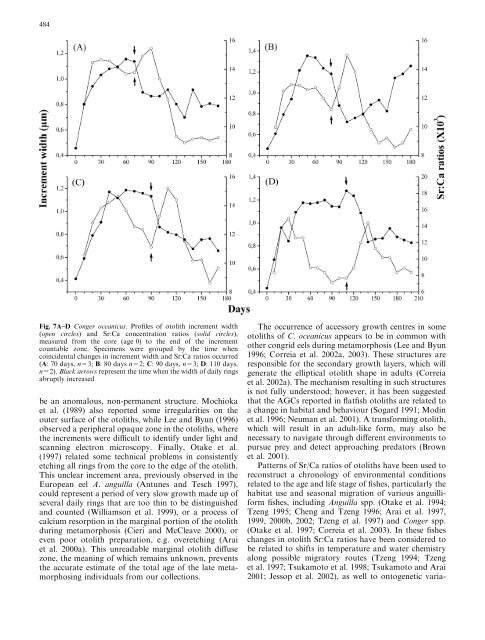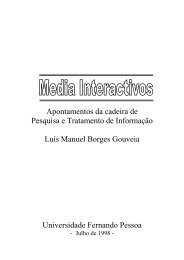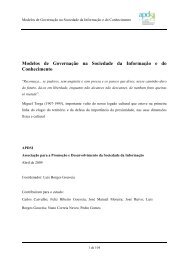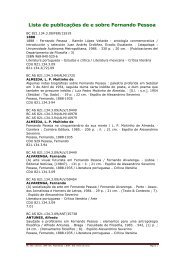Early life history of the American conger eel ... - ResearchGate
Early life history of the American conger eel ... - ResearchGate
Early life history of the American conger eel ... - ResearchGate
You also want an ePaper? Increase the reach of your titles
YUMPU automatically turns print PDFs into web optimized ePapers that Google loves.
484Fig. 7A–D Conger oceanicus. Pr<strong>of</strong>iles <strong>of</strong> otolith increment width(open circles) and Sr:Ca concentration ratios (solid circles),measured from <strong>the</strong> core (age 0) to <strong>the</strong> end <strong>of</strong> <strong>the</strong> incrementcountable zone. Specimens were grouped by <strong>the</strong> time whencoincidental changes in increment width and Sr:Ca ratios occurred(A: 70 days, n=3; B: 80 days n=2; C: 90 days, n=3; D: 110 days,n=2). Black arrows represent <strong>the</strong> time when <strong>the</strong> width <strong>of</strong> daily ringsabruptly increasedbe an anomalous, non-permanent structure. Mochiokaet al. (1989) also reported some irregularities on <strong>the</strong>outer surface <strong>of</strong> <strong>the</strong> otoliths, while Lee and Byun (1996)observed a peripheral opaque zone in <strong>the</strong> otoliths, where<strong>the</strong> increments were difficult to identify under light andscanning electron microscopy. Finally, Otake et al.(1997) related some technical problems in consistentlyetching all rings from <strong>the</strong> core to <strong>the</strong> edge <strong>of</strong> <strong>the</strong> otolith.This unclear increment area, previously observed in <strong>the</strong>European <strong>eel</strong> A. anguilla (Antunes and Tesch 1997),could represent a period <strong>of</strong> very slow growth made up <strong>of</strong>several daily rings that are too thin to be distinguishedand counted (Williamson et al. 1999), or a process <strong>of</strong>calcium resorption in <strong>the</strong> marginal portion <strong>of</strong> <strong>the</strong> otolithduring metamorphosis (Cieri and McCleave 2000), oreven poor otolith preparation, e.g. overetching (Araiet al. 2000a). This unreadable marginal otolith diffusezone, <strong>the</strong> meaning <strong>of</strong> which remains unknown, prevents<strong>the</strong> accurate estimate <strong>of</strong> <strong>the</strong> total age <strong>of</strong> <strong>the</strong> late metamorphosingindividuals from our collections.The occurrence <strong>of</strong> accessory growth centres in someotoliths <strong>of</strong> C. oceanicus appears to be in common witho<strong>the</strong>r congrid <strong>eel</strong>s during metamorphosis (Lee and Byun1996; Correia et al. 2002a, 2003). These structures areresponsible for <strong>the</strong> secondary growth layers, which willgenerate <strong>the</strong> elliptical otolith shape in adults (Correiaet al. 2002a). The mechanism resulting in such structuresis not fully understood; however, it has been suggestedthat <strong>the</strong> AGCs reported in flatfish otoliths are related toa change in habitat and behaviour (Sogard 1991; Modinet al. 1996; Neuman et al. 2001). A transforming otolith,which will result in an adult-like form, may also benecessary to navigate through different environments topursue prey and detect approaching predators (Brownet al. 2001).Patterns <strong>of</strong> Sr/Ca ratios <strong>of</strong> otoliths have been used toreconstruct a chronology <strong>of</strong> environmental conditionsrelated to <strong>the</strong> age and <strong>life</strong> stage <strong>of</strong> fishes, particularly <strong>the</strong>habitat use and seasonal migration <strong>of</strong> various anguilliformfishes, including Anguilla spp. (Otake et al. 1994;Tzeng 1995; Cheng and Tzeng 1996; Arai et al. 1997,1999, 2000b, 2002; Tzeng et al. 1997) and Conger spp.(Otake et al. 1997; Correia et al. 2003). In <strong>the</strong>se fisheschanges in otolith Sr:Ca ratios have been considered tobe related to shifts in temperature and water chemistryalong possible migratory routes (Tzeng 1994; Tzenget al. 1997; Tsukamoto et al. 1998; Tsukamoto and Arai2001; Jessop et al. 2002), as well to ontogenetic varia-
















